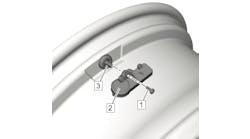I will make a bold assumption: you want to stay in the tire business, retire at some point and leave your business in better shape than you found it —or founded it. I also will assume you work on more of the vehicle than just its tires and rims. If this is you, keep reading.
My company, Automotive Career Development Center (ACDC), just took over the entire building we are in. I own the building and use 30% of it for hybrid electric vehicle (HEV) and electric vehicle (EV) training and rented the rest. My tenant left once their lease was up and we are in the process of upgrading the facility. The training we do is hands-on inside a shop, so our building looks like a repair facility.
If you are designing a new shop, here are the considerations to ensure it will be EV-ready:
- Install a 300-amp service or more with solar panels to cut costs;
- Install a level-one, level-two and a direct current fast charger (DCFC) - either the combined charging system (CCS) and/or a Tesla DC charger to verify the charging system when customers express concerns about their vehicles “not charging;”
- Add 240-volt outlets between each bay, so you can recharge EVs in that bay;
- Buy level-two electric vehicle supply equipment (EVSE) that can be swapped out from bay to bay;
- Build in extra flat space at the end of the EV bays - or all bays - so that a high-voltage battery can be removed and stored inside the shop;
- Create outdoor customer parking for EV owners with chargers, and’
- Place signage and park EVs in front of your shop. (Customers need to know you service EVs);
If you are adding an addition, all of the above still applies. Below is a low-budget solution to equipping an existing, older building. (ACDC is housed in an 80-year-old repair shop.)
- Use your 240 welding plug with a proper 240 extension cord to reach the EV with your level-two EVSE;
- Install a twin-post 10,000-pound lift with no drive-over plate;
- Store the battery in another bay or make a covered area outside;
- Know where the DCFCs are in your area.
Having a facility that is set up for EVs will allow you to service them faster and safer. A cost versus benefit study should be done before you spend any money. To recover the expense of gearing up to service EVs, allow a three-year payback time. Tools, training and advertising must be in place as you add EVs to your business growth plan.
Once your building is ready with your new equipment bolted in place, you will still need movable equipment, mostly to deal with the size and weight of a battery pack. (Hybrid packs are smaller than EV packs and are not typically repaired. Most hybrid packs are swapped out for new, used or rebuilt ones.)
Pure electric vehicle batteries today have a range of 200 to 400 miles on one charge. They are very large and heavy – weighing anywhere from 600 to 2,000 pounds. In addition, the cost of a new EV battery can be $8,000 or even more, so they are often repaired. You will need an EV battery lift table.
You may have read the news that General Motors and Ford are going to install a charging port currently used by Tesla vehicles, known as the North American Charging System (NACS) on their EVs.
GM and Ford have been using the current industry-standard Combined Charging System (CCS) ports in their electric vehicles. Tesla drivers have been able to use existing CCS chargers with a Tesla-made adapter that fits over Tesla charging plugs. Ford and GM EV owners will still be able to use CCS chargers with the use of an adapter after the switch to NACS, so you will need Tesla chargers in your shop.
As new technologies are created, this will change what we do and the way we do them. Staying current can be as simple as attending a new vehicle show or getting a feed into your email box from trusted information sources, such as this publication.
When I opened my repair shop in 1977, I ordered magazines. Many of them were free. It was there in 1994 that I learned about the California EV mandate, the lawsuits and ultimately the debut of the GM EV1 - then Toyota's original RAV4 EV, the Honda Insight and the Prius. The future was heading my way. Now the future is here.




